The Toyota Vios has been sold locally since 2003. Since then, it has become one of the most popular sedans in the market. It's commonly used as a family car, as a vehicle for public utility, and it even stars in Toyota Motor Philippine’s Vios Cup racing series. To this end, we can say that it’s definitely a very versatile car that can fulfill many different needs.
2020 Toyota Vios Facelift: Leveling up – First Look
But how does it compare to its main rivals here in the Philippines?
Toyota Vios: Specs Summary
The Vios, as many of you might already know, is a five-seater sedan with four doors. It uses a front-engine, front-wheel-drive layout, and it either uses a continuously variable transmission (CVT) or a five-speed manual transmission.
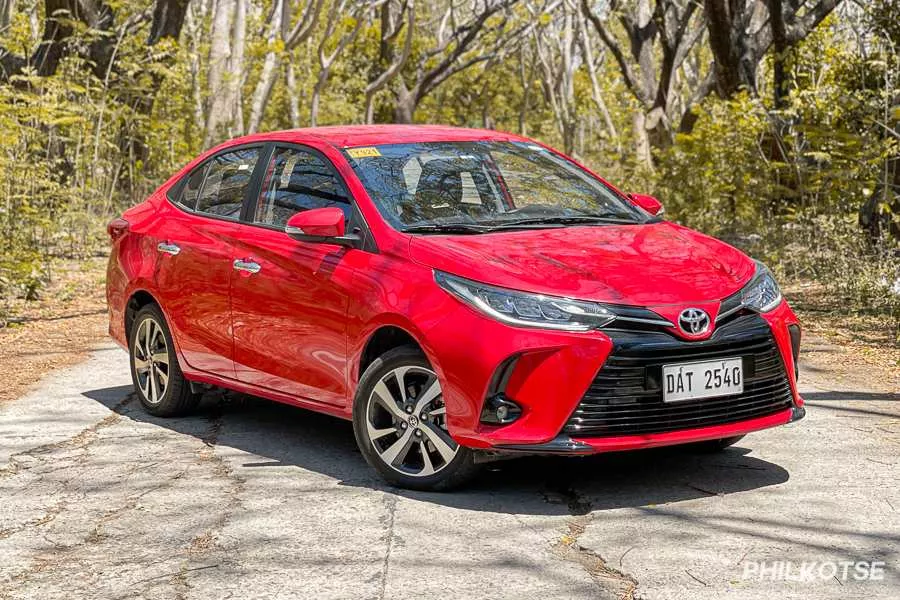
The Toyota Vios G
In terms of dimensions, it measures 4,425mm long, 1,730mm wide, and 1,475mm in height. It also has a wheelbase of 2,550mm, and a ground clearance of 133mm. Do note however that the top-spec Vios GR-S has a longer overall length of 4,467mm due to the addition of the Gazoo Racing body kits.
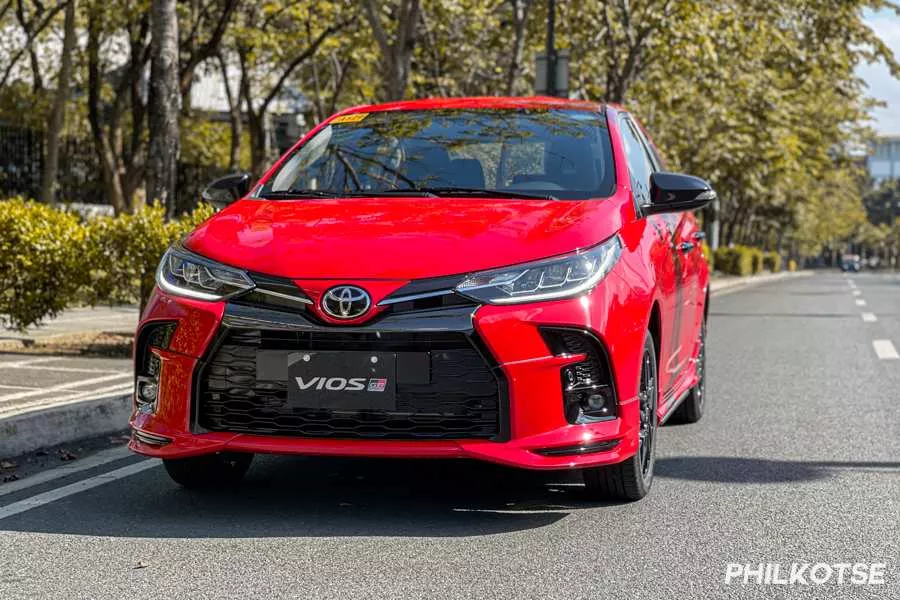
The Toyota Vios GR-S
For its engines, it either comes with a 1.3-liter or a 1.5-liter mill. Both are inline-4 engines, and both run on gasoline. The smaller engine that’s found on the Vios Base, J, XE, XLE and E trims is capable of making up to 98 horsepower and 123 Nm of torque. The larger engine found on the G and GR-S meanwhile, can produce up to 106 horsepower and 140 Nm of torque.
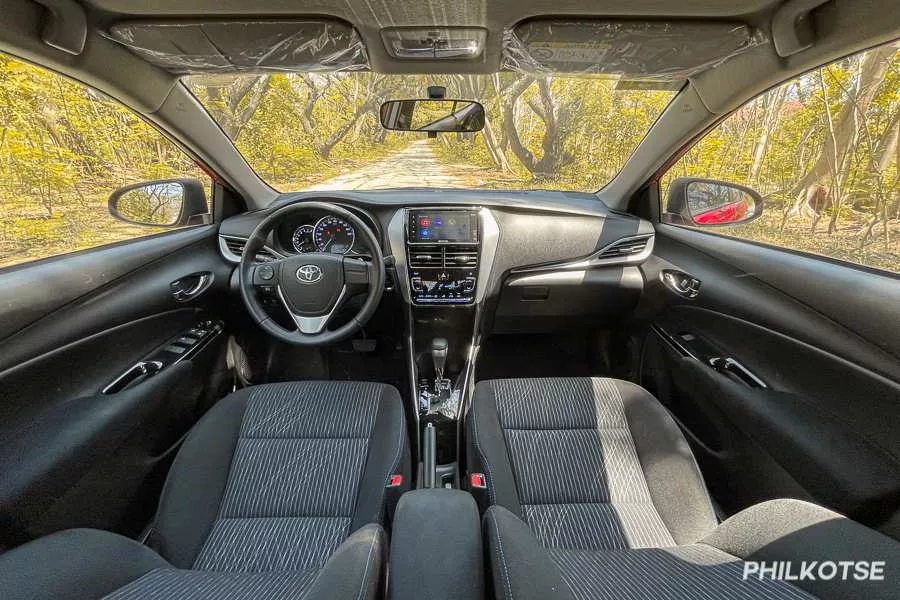
Inside the Toyota Vios G
Inside, the Vios gets an automatic air-conditioning system or manual AC depending on the variant. Also, it either gets a seven-inch touchscreen with Apple CarPlay and Android Auto, or a 2-DIN head unit depending on the trim. Save for the base model though, the Vios comes standard with stability control, hill-start assist, and a driver’s knee airbags. The higher-spec models starting with the Vios E, also come with more airbags totalling in seven.
As for pricing, the Toyota Vios ranges from Php 681,000 to Php 1,020,000.
Toyota Vios vs Nissan Almera
In terms of size, the Nissan Almera measures 4,425mm long, 1,695mm wide, and 1,505mm in height. Its wheelbase is 2,600mm long, and it has a ground clearance of 150mm. As such, it is just as long as the Vios, but it’s wheelbase is 50mm longer. It is also narrower but shorter. Lastly, it has more ground clearance.
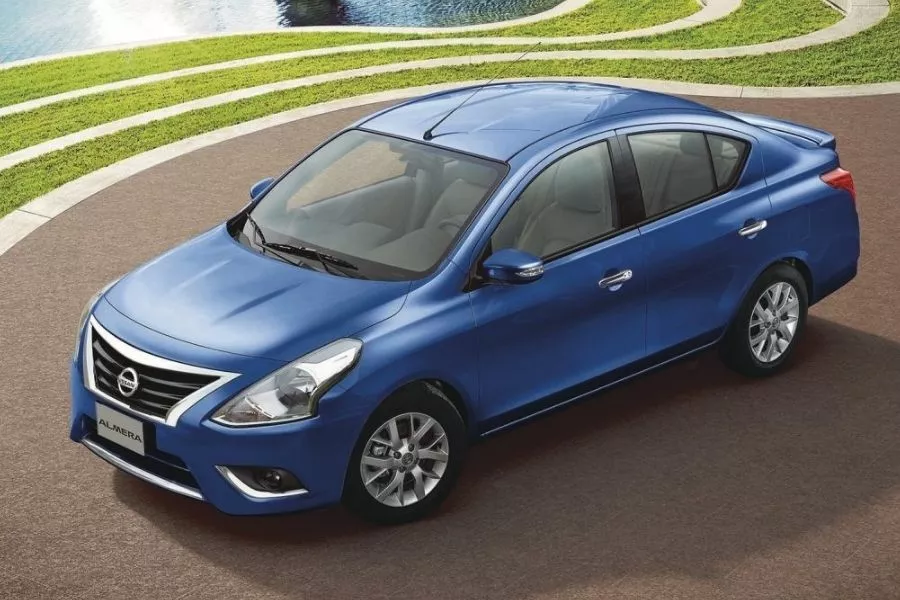
The Nissan Almera
Like the Vios, the Nissan Almera also assumes a front-engine, front-wheel-drive layout. It can also fit five passengers, and has two engine and transmission options.
The said engine and transmission options for the Nissan sedan however, are a bit different. The first engine for the lower variants is a 1.2-liter inline-4 capable of making 78 horsepower and 106 Nm of torque. The larger engine for the Almera is a 1.5-liter inline-4 that produces up to 98 horsepower and 134 Nm of torque. Suffice to say, the Toyota-made Vios obviously makes for horsepower and torque.
In terms of transmissions, the Almera’s smaller engine is only available with a five-speed manual transmission. In turn, the 1.5-liter Almera engine can only be paired with a four-speed automatic. This is in contrast to the Vios’ two engines, which can both come with either a CVT or a five-speed manual.
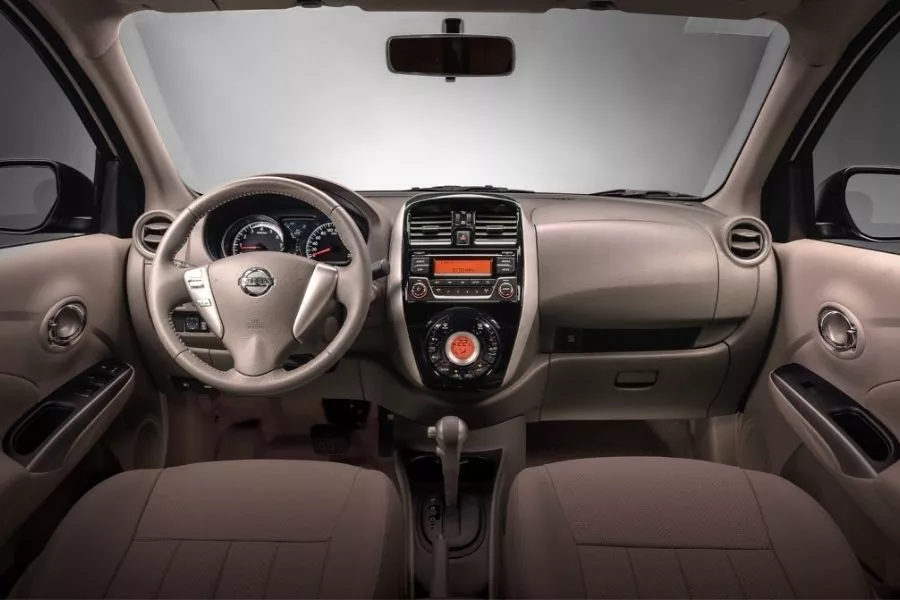
The Almera's cockpit
As with the Vios, the Almera can either get an automatic AC or manual depending on the variant. All Almera trims however, come standard with a 2-DIN, which is more frugal than the Vios’ touchscreen.
Safety-wise, all the Almera’s variants come standard with two airbags. This is in contrast to the Vios’ high-spec trims that come standard with seven. It does have anti-lock braking like the Vios.
Prices for the Almera starts at Php 657,000, with the top-spec variant currently sitting at Php 933,000. This means it has a comparable price range as the Vios, although it is slightly more affordable overall.
Toyota Vios vs Honda City
When it comes to size, the Honda City is the larger car compared to the Toyota Vios. That’s because its length measures 4,553mm, its width is 1,748mm, and its height is 1,476mm. Furthermore, its wheelbase is 2,600mm, which is also 50mm longer than the Toyota sedan’s wheelbase. It also has more ground clearance but the difference is only 4mm compared to the Toyota model.
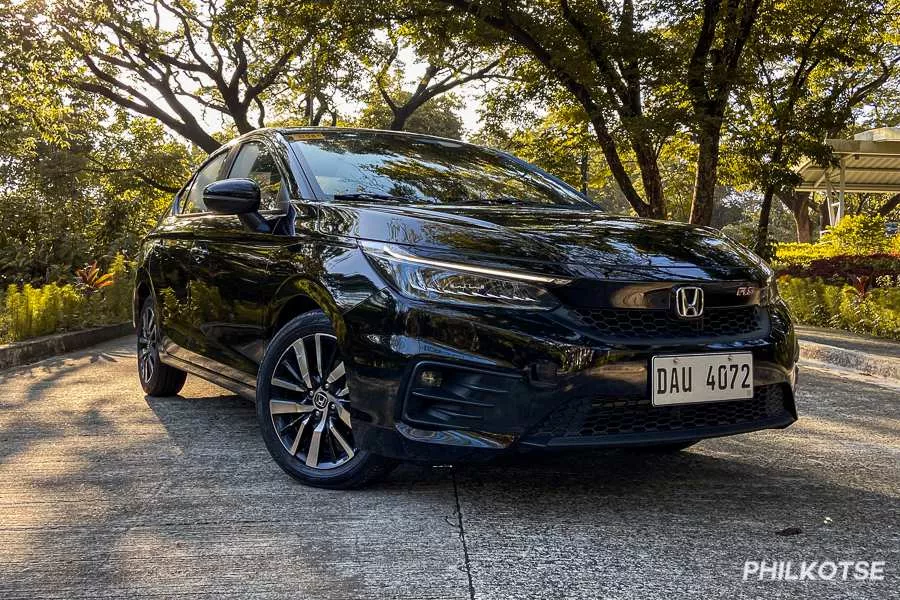
The Honda City RS
At most, the City can fit up to five people including the driver. Just like the Toyota model, it uses a front-wheel-drive, front-engine layout. But while the Vios has two engine choices, the City only has one. More specifically, it uses a 1.5-liter inline-4 gasoline engine capable of making up to 119 horsepower and 145 Nm of torque. On that note, the Honda-sedan's engine offers a bit more than the Vios’ 1.5-liter mill.
Just like the Toyota sedan however, the Honda-made subcompact also has two transmission options. The higher-spec City trims use a CVT and the entry-level variant comes with a six-speed manual gearbox. This is in contrast to the Vios whose mid-spec G variants can also come with a manual transmission. Although, the manual gearbox for the Vios is a five-speed.
As for on-board features, the City can either have an automatic air-conditioning system, or a manual AC depending on the trim. The lower spec variants are also equipped with a 2-DIN head unit, whereas the higher variants are kitted out with a seven-inch touchscreen with Apple CarPlay and Android Auto. So yes, the on-board entertainment systems on the City are more or less on-par with the one on the Vios.

Inside the Honda-made sedan
Safety-wise though, the higher variants of the Vios have seven airbags while the City has six. In turn however, the lower-spec City has four airbags, while the lower-spec Vios variants has three. And lastly, the City also comes standard with stability control, anti-lock braking, and hill-start assist just like the Toyota sedan.
Pricing for the Honda City’s four variants ranges from Php 848,000 to Php 1,058,000. Though its top-spec City RS variant is only slightly more expensive than the Vios GR-S, its entry-level manual variant is almost Php 170,000 more expensive than the Vios base model.
Toyota Vios vs Mitsubishi Mirage G4
Size-wise, the Toyota Vios is significantly larger than the Mitsubishi Mirage G4. Remember though that the Mirage G4 is based on the Mirage hatchback so this comes as no surprise.
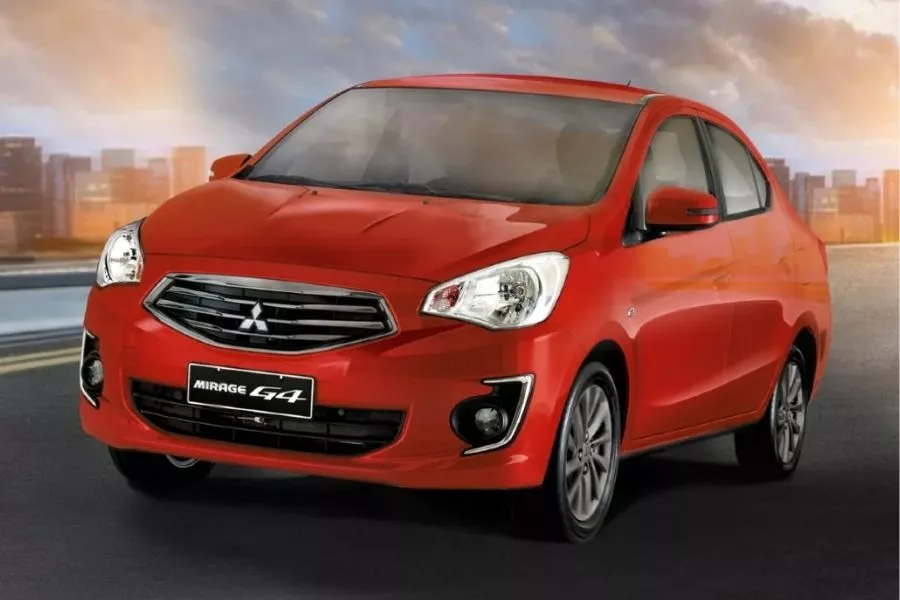
The Mitsubishi Mirage G4
To be more specific, the Mirage G4 is 4,305mm long, 1,670mm wide, and 1,515mm in height. Its wheelbase however is the same as the Vios at 2,550mm. Despite being a smaller model, the Mirage G4 offers significantly more ground clearance at 170mm. That’s 37mm more than the Toyota-made sedan.
Like the Vios, the Mirage G4 uses a front-wheel-drive, front-engine layout. The Mitsubishi sedan however only has one engine option, and it’s a 1.2-liter inline-3 engine. At most, this three-banger can make up to 77 horsepower and 100 Nm. This makes the Mirage G4 the least powerful model among the sedans we’re comparing to the Vios.
As with the Vios, the Mirage G4 can either come with a CVT or a manual transmission.
For interior specs, the Mirage G4’s trims can either come with a manual AC or automatic. The higher-spec variant also has a 6.75-inch touchscreen, but it has less in the way of smartphone connectivity compared to headunit found on the higher-spec Vios trims.
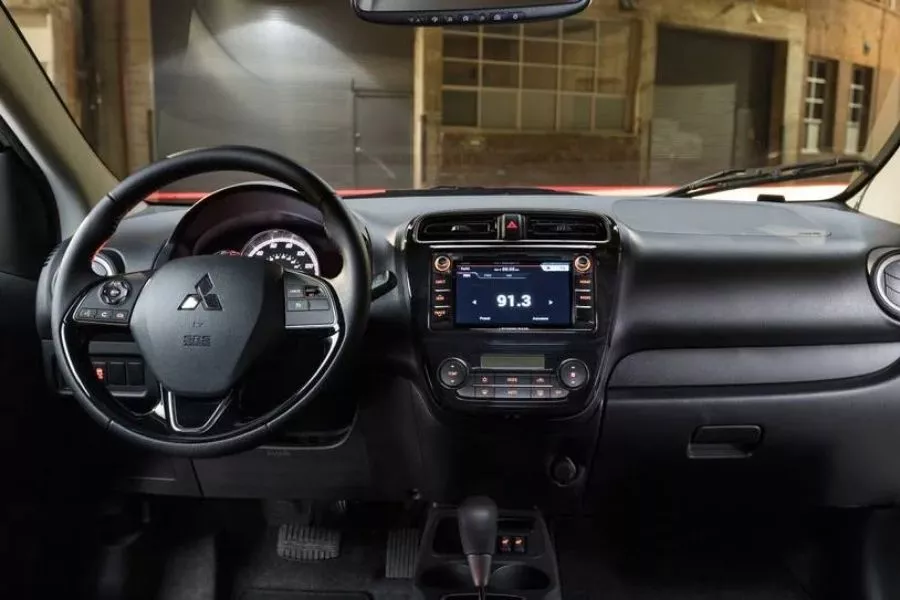
The Mirage G4's interior
The safety kit on the Mirage G4 is also bare when compared to the Toyota Vios. To be specific, even the Mitsubishi sedan’s top-spec variant only has two front airbags. Just like the Vios, the City, the Almera, and Accent though, the top-spec MIrage G4 does have anti-lock braking.
Prices for the Mitsubishi Mirage G4’s variants range from Php 735,000 to Php 869,000. So overall, it's a much more affordable model than the Vios.
Toyota Vios VS Hyundai Accent
When it comes to size, the Hyundai Accent measures 4,440mm long, 1,729mm wide, and 1,475mm tall. This means that it is slightly longer than the Toyota model. The Hyundai sedan however, is as wide and as tall as the Toyota. It’s wheelbase also has the same 2,600mm length as the Vios. Then again, it has marginally more ground clearance at 140mm.
In terms of layouts, the Accent is also front-engine, front-wheel-drive. Its engine options however, are markedly different from its competitors including the Toyota sedan. In fact, it is the only subcompact sedan model in the Philippines that can come with a diesel mill.
Specifically, the Accent diesel version uses a 1.6-liter that’s capable of churning out up to 128 horsepower and 260 Nm of torque. This makes it one of the most powerful subcompact sedans in its price range.

The Hyundai Accent
The other engine available to the Accent is a 1.4-liter inline-4 gasoline engine. At most this engine can make 100 horsepower and 132 Nm of torque, which compared to the Vios’ 1.5-liter, makes less output.
The Accent also has two transmission options. The first is a six-speed manual, and the other is a six-speed automatic.
Inside, the Accent comes standard with a manual air-conditioning system, a 3.6-inch LCD display, and two airbags. On this note, it is much more spartan than the Mirage G4, and even more so than the Vios.
Lastly, the Accent’s price ranges from Php 790,000 to Php 1,038,000. That said, it is slightly pricier than the Toyota Vios.
Did this guide help you compare the Toyota sedan against its rivals? If you want to learn more, do check out our reviews of the Toyota Vios G and Vios GR-S. For pricing, do check out our car guide section.
For more informative car buying and selling guides, keep it here on Philkotse.com.
Know more about Toyota Vios 2026

Competing in the subcompact sedan segment, the Toyota Vios 2025 is the top sales contributor for the Japanese automaker. The price for the Toyota Vios in the Philippines ranges from PHP 738,000 to PHP 1,039,000. A total of 7 Toyota Vios variants are offered, with the top-of-the-line Vios G CVT variant coming with a tag of PHP 1,039,000. Two engine options are available in the range, which can be connected to either a 5-speed manual or continuously variable transmission (CVT). Dimensions-wise, the subcompact sedan spans 4,425 mm in length, 1,730 mm in width, and 1,475 mm in height. The main rivals of the Toyota vehicle include the Honda City, Mitsubishi Mirage G4, and Nissan Almera.
The Toyota Vios is not only the best-selling model in the Japanese automaker's lineup, but the entire Philippine market. It serves as a reliable subcompact sedan for those who are looking for a daily driver. Also, the Vios is proudly Philippine-assembled which supports Filipino automotive workers. Now, the vehicle is competing in its respective class head high using the refreshed body released by Toyota Motor Philippines (TMP) in the country in 2020.
>>> New and used Toyota Vios 2025 for sale in the Philippines
Toyota Vios Launch
In 2002, Toyota introduced the first-generation Vios in the Philippines. A few years later in 2007, the second-generation sedan was launched. This version gained the "Batman" nickname due to the shape of its grille.
Several years onwards In 2013, Toyota brought in the third-gen Toyota Vios. It has grown in size, and it also came with a larger engine. The Toyota-made sedan was given a major update in 2018. It bore a new exterior design, and it also gained the upmarket Prime variants as well.
More recently in 2020, Toyota Motor Philippines launched another refresh of the Toyota Vios model. It's fitted with sportier fascia, a new grille, a new pair of headlamps, a revised foglamp housing, and a new lower grille, among others.
In March of 2021, TMP then introduced the Toyota Vios GR-S.
Toyota Vios Exterior
Up front, the Toyota Vios for the Philippines comes with a front end that mirrors the current designs of high-end models like the Corolla Altis and the Camry. The said design features a wide-slatted grille, flanked by the angular fog lamp housing. For the high-trim GR-S and G, the headlamps are three-tier LEDs with integrated LED daytime running lamps. The rest of the variants get a pair of four-bulb halogen headlights.
For the side and the rear, not much has changed since the previous version. The GR-S stands out from the rest of the variants with its black-colored exterior pieces, rear spoiler, and rear lower bumper with an integrated diffuser.
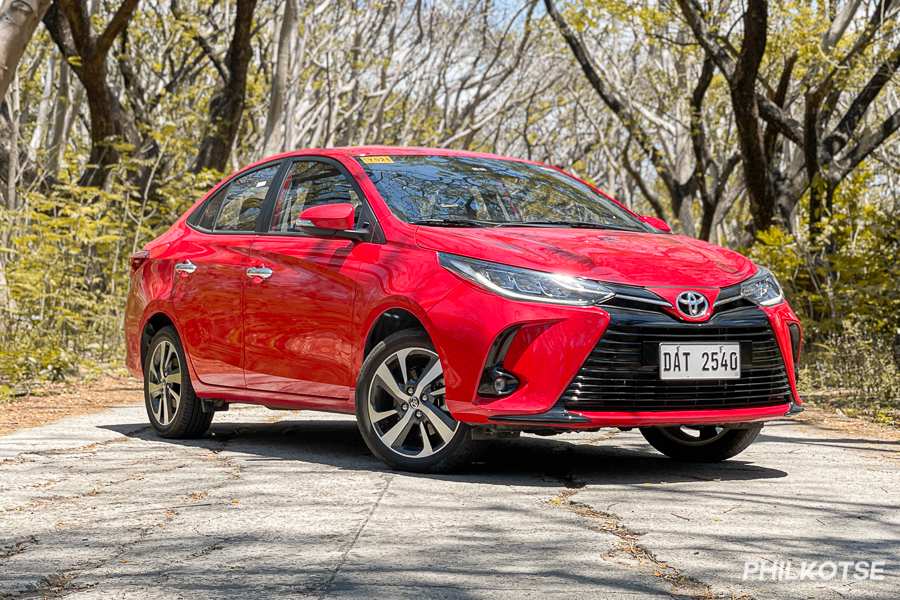
The Toyota Vios G
Apart from those, the Toyota Vios GR-S for the Philippine market also has different-looking side skirts and a set of GR-S 16-inch alloy wheels. The G variant on the other hand still has a piano black grille, but it gets chrome-plated door handles instead of the black-colored ones found on the GR-S.
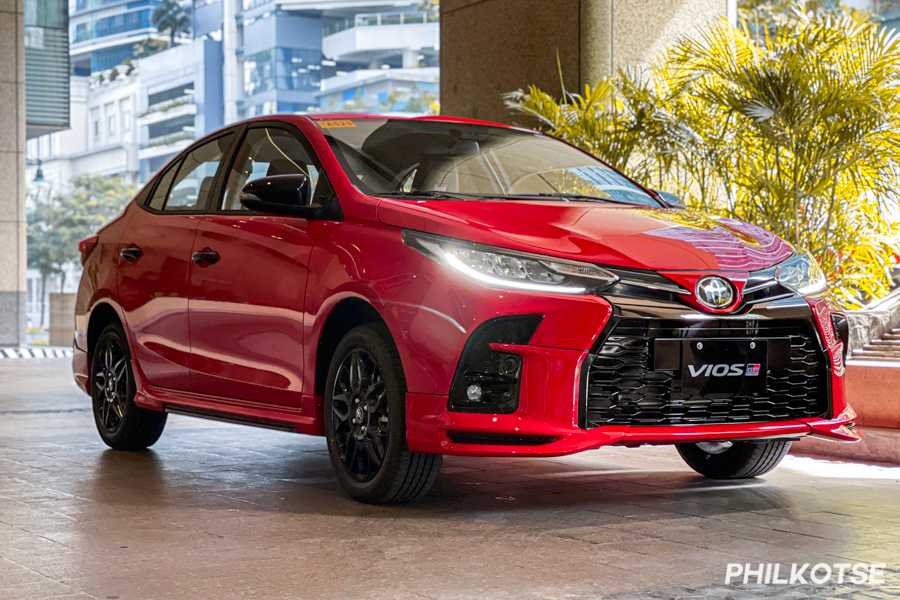
The all-new 2021 Toyota Vios GR-S
>>> Related: 2021 Toyota Vios GR-S review by Philkotse
Toyota Vios Interior
The Toyota Vios for the Philippine market can offer seating for up to five occupants including the driver. For the top-spec GR-S and G variants, they both come equipped with automatic air-conditioning. For the most part, the Toyota Vios' dashboard are made out of sturdy plastic, combined with silver-colored accents.
Soft touch points for the Vios are also abundant. The Toyota-made sedan's door cards are made out of a combination of plastic, and a soft, fabric-covered material. There's also the presence of a center elbow-rest.

The Interior Of The Toyota Vios G
As for the seats, most variants except the GR-S come with fabric seats. The GR-S instead has synthetic leather with red contrast stitching, combined with suede pieces.

The rear seats of the Toyota Vios
To keep occupants comfortable, both the GR-S and G Vios variants are equipped with automatic air-conditioning systems. The rest of the trim levels on the other hand come with a manual air-conditioning system.

Inside the Toyota Vios GR-S
>>> Related: Toyota Vios for sale at good prices on Philkotse.com
Features & Technology
For entertainment, the Toyota Vios GR-S, and the Vios G variants for the Philippine market come standard with a 6.75-inch touchscreen headunit. The said headunit is also capable of connecting via Bluetooth, USB, and Aux jack.

The Vios G's touchscreen headunit
The mid-tier XLE and XE trims also have the aforementioned headunit, but these come with a four-piece speaker set instead. The Vios J on the other hand comes standard with a 2-DIN audio unit linked to two speakers.
Besides the aforementioned touchscreen, the GR-S is also equipped with the Gazoo Racing 4.2-inch TFT multi-information display. Other variants do get an Optitron gauge cluster, as well as a multi-information display. The GR-S and the G also come with a push-to-start button, a leather-clad shift lever, and a drive-mode selector. All Vios variants also come standard with a tilt-adjustable steering wheel column.

The tech and convenience features will vary depending on the variant of the Toyota Vios
For safety, the GR-S and G variants are equipped with dual-front airbags, side airbags, curtain shield airbags, and driver's knee airbags. The rest of the trim levels have dual-front airbags, and the airbag for the driver's knee.
Anti-lock braking with electronic brake-force distribution, stability control, traction control, and hill-start assist are available on all Vios trims. Only the GR-S and G come with a rear-view camera, and only the former has a clearance sonar.
>>> See more: New and used Toyota Vios for sale in the Philippines at the best price
Platform & Chassis
The refreshed Toyota Vios for the Philippine market still uses the same platform as the previous model. As before, higher trim levels have disc brakes all around.
For suspensions, the Vios uses a MacPherson Strut type for the front and a torsion beam-type suspension for the rear. Moreover, the engine is still positioned transversely, with the power sent to the front wheels.
Engine & Drivetrain
The Toyota Vios for the Philippine market has two engine options. The larger one is a 1.5-liter inline-4 engine capable of making up to 106 hp and 140 Nm of torque. This said engine is available on the GR-S and the G Trim. For the former, it is paired to a continuously variable transmission (CVT) only. The Vios G can either come with a CVT or a five-speed manual transmission.

The Toyota Vios G's 1.5-liter mill
The other engine option for the Vios is a 1.3-liter inline-4 engine. At most, this mill can produce up to 98 hp, and 123 Nm of torque. For the XLE, the said engine can be paired with a CVT or a five-speed transmission. The 1.3 XE's sole transmission is a CVT, while the J comes standard with a five-speed manual transmission only.

The gear shift lever of the Vios GR-S
>>> Also check out:
- Toyota Vios 2020 Philippines Review: Join the club
- 2021 MG 5 vs Toyota Vios Comparison: Spec Sheet Battle
Toyota Vios 2025 Price List
| Variants | Price |
|---|---|
| Toyota Vios 1.3 J MT | ₱738,000 |
| Toyota Vios 1.3 XE CVT | ₱780,000 |
| Toyota Vios 1.3 XLE MT | ₱868,000 |
| Toyota Vios 1.3 XLE CVT | ₱908,000 |
| Toyota Vios 1.5 G MT | ₱979,000 |
| Toyota Vios 1.5 G MT (White Pearl) | ₱994,000 |
| Toyota Vios 1.5 G CVT | ₱1,039,000 |
₱ 732,000 - ₱ 1,055,000
ExploreRecent posts
- Latest Honda City Price Philippines 2026 Sep 23, 2025
- Latest Toyota Vios Price Philippines 2026 Sep 23, 2025
- Latest Hyundai Accent Price Philippines 2026 Jan 18, 2023
- Latest Nissan Almera Price Philippines 2026 Sep 23, 2025
















